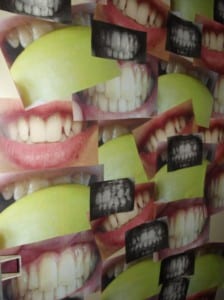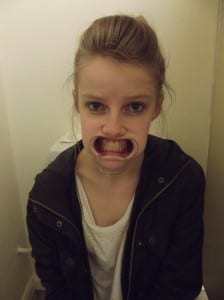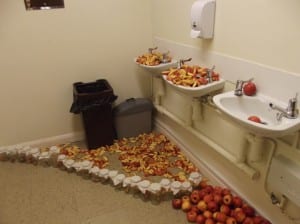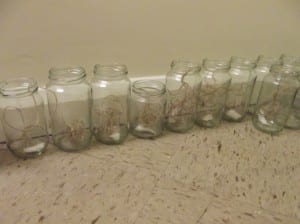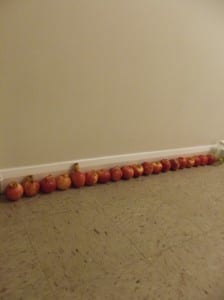Adam ate the apple and my teeth still ache, was a performance installation performed on the 8th of May with one on one audience member interaction, performed by two female artists in a ladies bathroom at the Grandstand in Lincoln. The piece explored the decomposition of the Grandstand and what the ‘core’ of the Grandstand was/is and its previous, present and future inhabitants, through Apples.
The concept originally derived, from Alice’s personal connection to the Grandstand. In which in one of the first weeks of development and research, we were asked to bring a gift to the Grandstand, Alice brought a perfume in a bottle shaped like an apple. Thus a narrative derived from the gift about how the apple had fallen from a special tree in which all the horses who ate from it won their race. Immediately the connection of Apples and horses became apparent, even more so with our site being a Grandstand which used to be a part of a racecourse. This later developed into the ideology that, the core of an apple represents the Grandstand, the surrounding apple/pieces of apple represents the previous, present and future inhabitants of the grandstand. Thus if our performance installation was to be placed in any other site the context would be completely irrelevant therefore applying the principles that is/are site-specific.
The performance installation took place in a ladies bathroom, in which an audience member entered by themselves one at a time and explored the space in full, looking around the open space where most were invited to wash apples in the sink with me and to re-core certain apples.Then exploring each toilet cubicle, two out of four cubicles just contained an audio, one of a horse eating an apple and the other playing a song by the Andrew sisters called Don’t sit under the apple tree with anyone else but me. In one cubicle we plastered pictures of Alice’s teeth scan, my teeth biting into an apple and horses teeth. In the final cubicle Alice sat with her hands and feet tied with twine, a cheek retractor in and the spiel of Appletite playing.
2/05/14 Lincoln Grandstand
2/05/14 Lincoln Grandstand
The piece took place for 15 minutes, twice every hour for 3 hours due to health and safety as Alice could not sit for any longer with a cheek retractor in.
The audience’s part in the final performance was vital, in previous weeks whilst ‘rehearsing’ we were unable to imagine and re-create weekly what the space would look like in the final performance due to the vast amount of apples and jars that were needed and the arrangement that we could only get those there on the day of the performance. Thus throughout the creative process it was difficult to practice so to say to audience members, therefore it was all or nothing on the performance day which although nerve-racking was also exhilarating seeing the whole process and hard work come together. Having no pre-conceptions of what to expect from audience members, it added to the experience as many were willing to interact and wash apples, however others just wanted to explore and watch. Some vocalised their thoughts and feelings, others were completely silent throughout the whole exploration, and this made each performance unique to each audience member who experienced it, an advantage of using one to one performance.
Pearson notes that site-specific performance ranges “…from taking audiences to unusual sites, to bringing unusual sites to them.” (Pearson, 2010, p.5) This is true in the case of our piece. Firstly taking audiences to an usual site, the Grandstand. Although some members of the audience may be familiar as to what a Grandstand is and what its purpose is, when they arrive they do not expect to be seeing a performance, especially not within the context they normally associate performing with. Secondly, bringing unusual sites to them also applies to our performance piece. In the ladies bathroom, we installed approximately 300 apples and around 130 jars, filled with decomposing apples and tea lights; a site we presume is unusual to most audience members.
As mentioned previously, the connection of apples and the Grandstand was initiated by Alice’s personal gift to the grandstand. With guidance, we knew we wanted to have apples heavily involved in our piece due to the connection that horses eat apples; horses were and are still present at the Grandstand.
Firstly we experimented with a corridor as our original performance space; it had full length windows on one side and was full of natural light shining through from outside, much like a greenhouse. We thought this narrow spaced corridor would be brilliant for creating an installation piece by aligning our jars of decomposed apples, re-creating a production line in which the apples would go from fresh to rotting/de-composed, re-iterating the decomposition of the Grandstand.
Our research became concentrated on apples and everything or anything to do with apples. An apple is the fruit of knowledge, Sir Isaac Newton found the notion of gravity due to an apple falling on his head, and it’s a forbidden fruit in the bible. Initially from our first research, we decided to concentrate on the biblical aspect of the apple, looking at apple sayings and references in the bible for example;
“When the woman saw that the fruit of the tree was good for food and pleasing to the eye, and also desirable for gaining wisdom, she took some and ate it. She also gave some to her husband, who was with her and he ate it.” (Gen 3.6)
However whilst exploring the Grandstand as a space further, we then found the ladies bathroom towards the rear of the Grandstand,which led off of our original corridor ‘performance space’. This new ‘found’ space excited us, it seemed appropriate for what we were trying to create. The space gave off an eerie ‘vibe’ even though there is a prominent sound of an extractor fan.
Whilst experimenting in the space we developed a divide between the space, creating two performance spaces. One area being a wide open space in which the bathroom sinks are situated with a mirror on one wall and a door on the adjacent wall. The other space consists of the toilet cubicles and a very ‘peculiar triangular pointed’ corner. We decided to experiment with the first performance space being the ‘Biblical space’ and the second as the ‘personal space’. The ‘Biblical’ performance space really developed in one week’s session. Our tutor, Michael noted to us that the space can ‘give’ you ideas and thoughts in a sense, for example the mirror on the wall. If you stood looking into the mirror at the door and another person stood looking into the mirror from the door you could create this contact that was personal yet distant. We’d been experimenting with different texts relating to apples and the importance of the fruit.
In the ‘personal’ space, which we had developed and worked in, in previous weeks we experimented with this being a space where the audience learnt about Alice’s personal experience with apples. We recorded a text that Alice had written which was a brief history of why she cannot eat apples, named Appletite. This played on a speaker in a toilet cubicle whilst Alice stared at the audience member who was stood in the ‘corner’. This as Mike Pearson notes used the architecture of the building to “…impose new arrangements with the audience in lines, alleys or blocks to conspire effects of distance, closeness, obliqueness, etc.” (Pearson, 2010, p.176)
After bringing an audience member into the space, we received some feedback which helped shape our piece drastically into what it became in final performance. The audience member enjoyed the spiel of Alice’s personal connection with apples and we received notes to incorporate key words into the text relating to apples, horses or the Grandstand. Therefore we added these to the text as shown below;
“…That was until the cores of my two most visible teeth decided to grow wrong. When I say wrong, I mean they grew through as if I were a baby vampire. From the ages of nine until eleven, I never smiled in pictures, and became reliant on eating with my molars. I found myself more tempted by foods that usually I had no interest in. After numerous trips to the orthodontist, it seemed my only option was to have the pips removed, and tracks of braces to fill in the gaps…” (Saxton, 2014)
Although the audience member also enjoyed the biblical reference, they noted that the configuration of looking into the mirror and talking to the audience member could create potential issues of not being able to see each other properly, thus losing the personal connection intended. From this we adapted the ‘biblical’ space and focused more on creating an installation in the area with the jars and apples we had, having the sinks over flowing with apples as shown in the pictures below;
08/05/14 Lincoln Grandstand
As noted in the early stages of the creative process, the bathroom had a strong sanitary smell of bleach; this sanitary and quite clinical smell was something that the audience experienced as soon as they entered the space as it was very overwhelming. Due to this I decided to research into site and sense. We understood that as humans, everything we know in life is recognisable due to our senses. Be it, sight, hearing, taste, touch and smell. These senses can also evoke the mind and bring back memories of the past.
From research we found that this concept, of exploring sense in site specific performance had been adapted by several solo artists and companies. Curious, in their performance entitled “On the Scent” (rather fitting) explored the sense of smell and led audience members on a guided tour through different rooms in the house, which had different scents and performers doing different activities.This particular exploration of the senses inspired me to relate this to our potential performance idea’s revolving around apples. First was the obvious smell created by apples, both fresh and rotting; both can be overwhelming in great quantities which we established we both wanted to work with mass amounts of apples.
Applying this also to most people’s interest in the potential for the site to have been a mortuary, I thought there could be a potential to experiment with making a particular space smell ‘clinical’. For example the space that is now used as a kitchen was planned to be a ‘Sluicing’ room, where bodies would be washed down and would hence have to be very clean and hygienic, much like a kitchen. However you could also ‘flip’ this around and either make a space that should ideally be clean, smell disgustingly filthy such as the scent of rotting apples, or make a space that is filthy smell clean.
The clinical smell, was adapted for our final performance piece and influenced us in terms of costume, for example Alice’s personal connection was because she couldn’t bite into apples due to her false capped teeth, this linked with the dentist who told her she was unable to eat apples, which then connected to the clinical smell within the bathroom and our costume; which was a dentists ‘apron’ and Alice wore a bib, given to us by a dental practice. This concept of sense and smell in particular was then applied to our piece, with the mass amount of apples we had (300+) which amplified and filled the space with the smell of apples much like Curious did, filling the house with different scents.
Another artist’s work that coincides with our piece was that of Sam Taylor-Wood and in particular the piece Still Life which was a film created in 2001 that looked at the decomposition of a fruit bowl with contexts of life, death and decay. This was very much like our piece, the decomposition of the fruit bowl represented the inevitability of decomposition of life leading to death, much like the decomposition of the Grandstand losing its true purpose, losing life and decaying. Like Sam Taylor- Wood we documented part of the decomposition but instead of using this to make a film, we decided to showcase the decomposition of the apples and apple cores in jars and place them in the performance space.
Whilst experimenting in our decided performance space of the bathroom, and using Tim Etchells notion of play in which he notes “play as a state in which meaning is flux, in which possibility thrives, in which versions multiply in which the confines of what is real are blurred, buckled, broken. Play as endless transformation, transformation without end and never stillness.” (Etchells, 1999, p.53) we decided to use this notion to indeed encourage possibilities to thrive, therefore when the idea of originally putting apple slices in the sinks was first and foremost for storage we never intended the possibility of it being a key feature in our final performance. We noted that it was quite a strong visual and increased the smell of apples within the space, therefore we decided together that we would fill the sinks with apple slices and when it came to the final performance several audience members were impressed with the image.
Without a doubt when the time arrives in the creative process when you have to name your piece, I personally find it difficult. You want to give your piece the justice you believe it deserves, and the wording of a title can be interpreted in so many different ways that it is so important to get it right. When deciding on a title for our piece, we first though of Appletite from the text we had written about Alice’s teeth. We liked the clever play on words, however we realised this perhaps didn’t link to the Grandstand or represent our work clearly. Therefore we looked back on our research of apple sayings and references. We were struck by the biblical reference “Adam ate the apple and our teeth still ache” which was re-iterating the consequences of Adam and Eve eating the forbidden fruit. Whilst playing around with the saying I noted that we should change the ‘our’ to ‘my’, this meant that the title had reference to apples, the biblical aspect and by changing it to ‘my’ linked to the personal connection with Alice and exploration of our piece.
The final performance, overall I believe was successful; we produced a performance installation which had a clear and deeper contextual connection with the site. We had elements of pre-performance, performance and post-performance, in which we had audiences members explore the space and see the jars of decomposed apples as the pre-performance, then for the performance they were invited to wash apples. As regards the post-performance we collected in jars after each 15 minute interval of performance, the cotton wool and twine Alice had used. For each audience member that came to see the piece, I also re-cored an apple. As seen below;
08/05/14 Lincoln Grandstand
08/05/14 Lincoln Grandstand
Throughout the duration of the piece, several audience member’s involvement and reactions to the piece were positive. They engaged with tasks such as washing apples in a sink and explored the space fully like intended. However after one performance, a few audience members waited to speak to us, they spoke of how they liked the piece and had an idea as to what the piece was about but wanted clarification, this is both a strength and a weakness. Firstly, it’s a strength as they had a positive response to the piece, they liked the piece and were intrigued by the work and wanted to know more. However it was also a weakness as perhaps we hadn’t got across the connection as clearly as the audience perhaps hoped. I say as the audience hoped, due to the fact that it was an artistic decision between Alice and I not to bombard and literally tell the audience the connection between the piece and the site to leave some room for personal interpretation.
If I could go through the creative process again, I think I would research further into apples and horses, looking further into the connection between and somehow focusing more on how we could visually represent the importance of horses at the Grandstand and the lack of them racing there now. This added research and representation I believe would make it clearer to audience members the connection and the purpose of the piece without as previously mentioned, telling them. I also would make sure the decomposed apples in the jars were more noticeable. Although the audience could clearly tell there was a mass amount of jars present; some didn’t notice the decomposed apples which represented the decomposition of the Grandstand. Therefore we could have displayed the jars on a table for the audience to see clearer. As well as displaying the jars clearer, if I could do it again I would prepare more decomposed apples, the same amount as fresh apples we had in the sinks so that, that visual was also overwhelming however this as we established throughout our process was and is costly.
My experience of studying and performing as a site-specific artist has developed me as a person which I did not expect, it enabled me to approach both theoretical and practical practices with an open mind thus allowing me to further my knowledge in theatre and performance practice. It also gave me the opportunity to experience great and influential work from artists I had not previously been aware of and create new and innovative work myself.
Word Count:2,935.
Bibliography:
Apple Text Genesis 3.6
Curious, On the Scent [online] Available from http://www.placelessness.com/project/1121/on-the-scent/ [Accessed 05/03/2014]
Etchells, T. (1999) Certain Fragments, Contemporary Performance and Forced Entertainment. New York: Routledge.
Pearson, M. (2010) Site-Specific Performance. London: Palgrave Macmillian.
Saxton, A. (2014) Appletite.
Taylor-Wood, S. (2001) Still Life. [online] Available from http://disembedded.wordpress.com/2008/04/10/sam-taylor-wood-still-life-and-the-acceptance-of-mortality/ [Accessed 18/04/2014]

